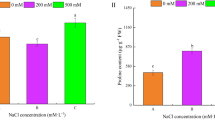Abstract
Ascorbate peroxidases (APXs) play an essential role in H2O2 scavenging by converting it into H2O in living cells, and eight APXs have been annotated in the rice genome (Oryza sativa L. cv. ‘Nipponbare’). We conducted mass spectrometric sequencing of a protein pool, obtained using an APX in-gel assay, to retrieve salt-inducible genes from a salt-sensitive rice cultivar (O. sativa L. cv. ‘IR-29’) using liquid chromatography–tandem mass spectrometry. We selected seven candidates from the peptide sequencing output, and performed reverse transcription-polymerase chain reaction to evaluate the candidates for inducible expression against salt treatment (100 mM NaCl). Two orthologs of OsAPX1 and OsAPX2 (OsAPX1-IR29 and OsAPX2-IR29, respectively) were found, and in vitro recombinant enzyme assays revealed that both OsAPX1-IR29 and OsAPX2-IR29 could convert H2O2 into H2O by using ascorbate as the electron donor, with 10- to 15-fold higher enzymatic activity than that of a crude extract. OsAPX2-IR29 transcripts were significantly more abundant than OsAPX1-IR29 transcripts in the shoot. However, after salt treatment, OsAPX1-IR29 transcripts were highly induced, depending on salt concentration (greater than threefold) and time (greater than sixfold). Furthermore, we observed a similar APX protein accumulation pattern using isoform-specific antibodies. Importantly, transcript levels markedly increased 5 days after salt treatment, and were consistently maintained until 7 days after treatment, although the seedlings sustained serious damage and showed no indication of viability. Our results suggest that OsAPX1-IR29 and OsAPX2-IR29 are the major APX isozymes, and play significant roles in scavenging H2O2 during salt stress in the IR-29 cultivar.





Similar content being viewed by others
References
Agrawal GK, Jwa NS, Iwahashi H, Rakwal R (2003) Importance of ascorbate peroxidases OsAPX1 and OsAPX2 in the rice pathogen response pathways and growth and reproduction revealed by their transcriptional profiling. Gene 322:93–103
Apel K, Hirt H (2004) Reactive oxygen species: metabolism, oxidative stress, and signal transduction. Annu Rev Plant Biol 55:373–399
Bahk YY, Kim SA, Kim JS, Euh HJ, Bai GH, Cho SN, Kim YS (2004) Antigens secreted from Mycobacterium tuberculosis: identification by proteomics approach and test for diagnostic marker. Proteomics 4:3299–3307
Basu S, Roychoudhury A, Saha P, Sengupta D (2010) Differential antioxidative responses of indica rice cultivars to drought stress. Plant Growth Regul 60:51–59
Bradford MM (1976) A rapid and sensitive method for the quantitation of microgram quantities of protein utilizing the principle of protein-dye binding. Anal Biochem 72:248–254
Hong CY, Hsu YT, Tsai YC, Kao CH (2007) Expression of ASCORBATE PEROXIDASE 8 in roots of rice (Oryza sativa L.) seedlings in response to NaCl. J Exp Bot 58:3273–3283
Kawasaki S, Borchert C, Deyholos M, Wang H, Brazille S, Kawai K, Galbraith D, Bohnert HJ (2001) Gene expression profiles during the initial phase of salt stress in rice. Plant Cell 13:889–905
Lazzarotto F, Teixeira FK, Rosa SB, Dunand C, Fernandes CL, de Vasconcelos Fontenele A, Silveira JAG, Verli H, Margis R, Margis-Pinheiro M (2011) Ascorbate peroxidase-related (APx-R) is a new heme-containing protein functionally associated with ascorbate peroxidase but evolutionarily divergent. New Phytol 191:234–250
Lee MH, Cho EJ, Wi SG, Bae H, Kim JE, Cho JY, Lee S, Kim JH, Chung BY (2013) Divergences in morphological changes and antioxidant responses in salt-tolerant and salt-sensitive rice seedlings after salt stress. Plant Physiol Biochem 70:325–335
Lu Z, Liu D, Liu S (2007) Two rice cytosolic ascorbate peroxidases differentially improve salt tolerance in transgenic Arabidopsis. Plant Cell Rep 26:1909–1917
Mittler R, Vanderauwera S, Suzuki N, Miller G, Tognetti VB, Vandepoele K, Gollery M, Shulaev V, Van Breusegem F (2011) ROS signaling: the new wave? Trends Plant Sci 16:300–309
Moradi F, Ismail AM (2007) Responses of photosynthesis, chlorophyll fluorescence and ROS-scavenging systems to salt stress during seedling and reproductive stages in rice. Ann Bot 99:1161–1173
Nakano Y, Asada K (1981) Hydrogen peroxide is scavenged by ascorbate-specific peroxidase in spinach chloroplasts. Plant Cell Physiol 22:867–880
Salekdeh GH, Siopongco J, Wade LJ, Ghareyazie B, Bennett J (2002) A proteomic approach to analyzing drought- and salt-responsiveness in rice. Field Crops Res 76:199–219
Schmittgen TD, Livak KJ (2008) Analyzing real-time PCR data by the comparative CT method. Nat Protoc 3:1101–1108
Shigeoka S, Ishikawa T, Tamoi M, Miyagawa Y, Takeda T, Yabuta Y, Yoshimura K (2002) Regulation and function of ascorbate peroxidase isoenzymes. J Exp Bot 53:1305–1319
Teixeira F, Menezes-Benavente L, Margis R, Margis-Pinheiro M (2004) Analysis of the molecular evolutionary history of the ascorbate peroxidase gene family: inferences from the rice genome. J Mol Evol 59:761–770
Teixeira F, Menezes-Benavente L, Galvão V, Margis R, Margis-Pinheiro M (2006) Rice ascorbate peroxidase gene family encodes functionally diverse isoforms localized in different subcellular compartments. Planta 224:300–314
Tsai YC, Hong CY, Liu LF, Kao CH (2005) Expression of ascorbate peroxidase and glutathione reductase in roots of rice seedlings in response to NaCl and H2O2. J Plant Physiol 162:291–299
Van Breusegem F, Dat JF (2006) Reactive oxygen species in plant cell death. Plant Physiol 141:384–390
Yan S, Tang Z, Su W, Sun W (2005) Proteomic analysis of salt stress-responsive proteins in rice root. Proteomics 5:235–244
Zuo X, Echan L, Hembach P, Tang HY, Speicher KD, Santoli D, Speicher DW (2001) Towards global analysis of mammalian proteomes using sample prefractionation prior to narrow pH range two-dimensional gels and using one-dimensional gels for insoluble and large proteins. Electrophoresis 22:1603–1615
Acknowledgments
This study was supported by the Nuclear R & D Program of the Ministry of Science, ICT, and Future Planning (MSIP), Republic of Korea.
Author information
Authors and Affiliations
Corresponding author
Additional information
Sungbeom Lee and Moon-Soo Chung have contributed equally to this study.
Electronic supplementary material
Below is the link to the electronic supplementary material.
Rights and permissions
About this article
Cite this article
Lee, S., Chung, MS., Kim, J.E. et al. Liquid chromatography-tandem mass spectrometry-assisted identification of two salinity-inducible ascorbate peroxidases in a salt-sensitive rice cultivar (Oryza sativa L. cv. ‘IR-29’). Plant Growth Regul 75, 143–153 (2015). https://doi.org/10.1007/s10725-014-9939-3
Received:
Accepted:
Published:
Issue Date:
DOI: https://doi.org/10.1007/s10725-014-9939-3




